When it comes to selecting the perfect wooden door design for your home, the type of wood used is a crucial factor. Choosing the right wood for your doors is crucial for achieving the perfect balance of aesthetics, durability, and functionality. The choice of wood not only influences the door’s durability but also adds character and elegance to your living spaces. In this blog, we will delve into the world of various wood types commonly used for doors, discussing their unique features, benefits, and considerations. By understanding the characteristics of different wood species, you can make an informed decision that aligns with your aesthetic preferences and functional needs.
Post your Requirement
Birch Wood:

Birch wood is known for its light color and fine, straight-grain patterns. It offers a smooth and uniform appearance, making it an excellent choice for contemporary door designs. Birch is relatively affordable and readily available, making it an attractive option for those on a budget. However, it is important to note that birch is a softer wood and may require additional protection against dents and scratches.
Advantages of Birch Wood
- Light color and fine, straight-grain patterns create a sleek and uniform appearance.
- Relatively affordable compared to some other wood types, making it budget-friendly.
- Readily available, ensuring easy accessibility for buyers.
- Easy to work with and customize due to its softer nature.
- Accepts stains and finishes well, allowing for various color options.
- Can be a suitable choice for contemporary door designs.
Disadvantages of Birch Wood
- Softer wood compared to some hardwoods, making it more susceptible to dents and scratches.
- May require additional protection or maintenance to prevent damage.
- Limited natural color options, typically ranging from light yellow to pale brown.
- Some may prefer the look of a more pronounced grain structure found in other wood species.
- Less durable compared to harder woods, potentially affecting longevity.
- Requires careful consideration of usage and protection in high-traffic areas.
Teak Wood:

Teak wood is highly regarded for its exceptional durability and natural resistance to moisture, making it ideal for exterior doors. Its rich, golden brown color and unique wood grain add elegance and warmth to any space. Teak wood door design is often favored for its longevity and ability to withstand harsh weather conditions. Although teak wood may be more expensive, its remarkable durability and striking appearance make it a worthwhile investment.
Advantages of Teak Wood
- Exceptional durability and resistance to moisture, make it ideal for outdoor applications.
- Rich, golden brown color with unique grain structure, adding elegance and warmth to spaces.
- Natural oils present in teak wood provide protection against rot, decay, and pests.
- Longevity and ability to withstand harsh weather conditions.
- Low maintenance requirements, requiring minimal treatment or finishing.
- Highly sought after for its luxurious appearance and reputation.
Disadvantages of Teak Wood
- Higher cost compared to many other wood types.
- Limited availability in certain regions, impacts accessibility.
- Heavyweight, requiring proper installation and support.
- Over time, teak wood may develop a silvery-gray patina if left untreated.
- Oil content can make bonding or finishing challenging.
- Sustainable sourcing can be a concern, so it’s important to ensure responsible procurement.
Alder Wood:
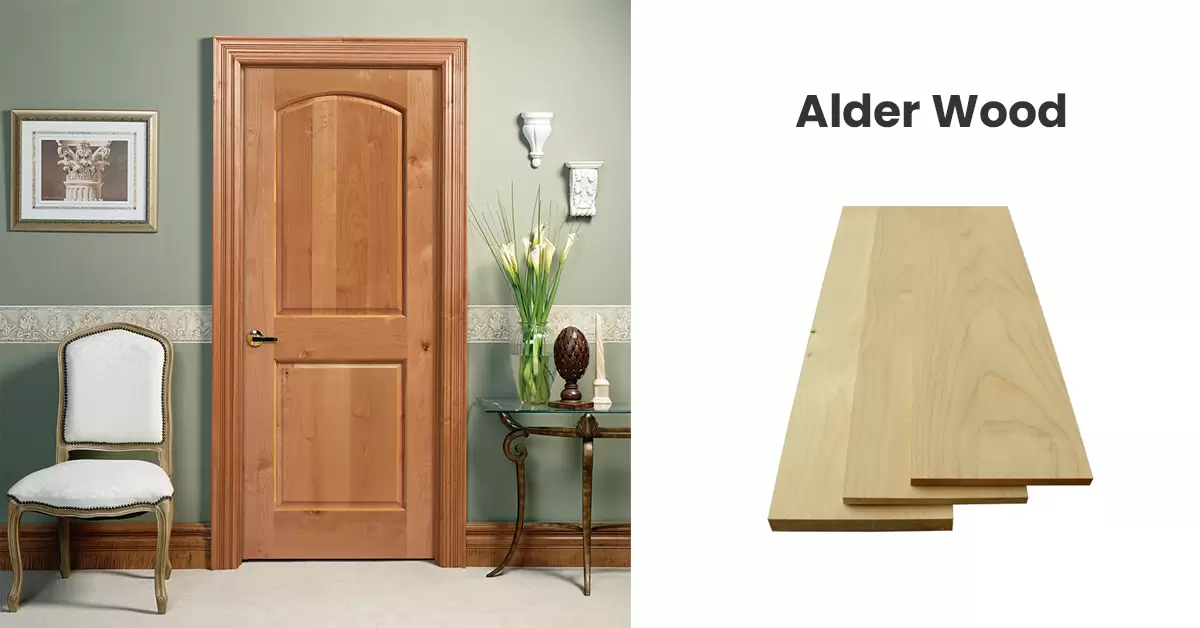
Alder wood exhibits a distinct blend of rustic charm and versatility. It is characterized by its light brown to reddish-brown color and subtle texture. Alder is a relatively soft wood, making it easy to work with and customize. It is often chosen for its affordability and ability to be stained to resemble other expensive wood species. However, it is important to note that alder may be more prone to dents and scratches compared to harder wood.
Advantages of Alder Wood
- Light brown to reddish-brown color with subtle and attractive texture.
- Relatively affordable compared to some other wood types, making it a cost-effective option.
- Easy to work with and customize due to its softer nature.
- Accepts stains and finishes well, allowing for versatility in achieving desired aesthetics.
- Can be an excellent alternative for achieving the look of more expensive wood species.
- Adds a rustic and warm charm to spaces, making it popular for certain design styles.
Disadvantages of Alder Wood
- Softer wood compared to some hardwoods, making it more prone to dents and scratches.
- Requires proper care and maintenance to protect against damage.
- Limited natural color options, typically ranging from light brown to reddish tones.
- May not possess the same level of durability as harder wood species.
- Grain patterns may be less prominent compared to other woods, which can be a personal preference.
- Not as widely available as some other wood types, potentially impacting accessibility.
Poplar Wood:

Poplar wood is valued for its light color, uniform texture, and straight wood pattern. It is often used as a less expensive alternative to hardwoods like maple or cherry. Poplar is a relatively soft wood, making it easier to work with and suitable for intricate door designs. While it may lack the same level of durability as other hardwoods, proper finishing, and maintenance can help protect poplar doors and maintain their appearance.
Advantages of Poplar Wood
- Light color and uniform texture create a clean and versatile look.
- Relatively affordable compared to many hardwood options, making it budget-friendly.
- Easy to work with and customize due to its softer nature.
- Accepts stains and finishes well, allowing for various color options.
- Suitable for intricate designs and detailing.
- Widely available, ensuring easy accessibility for buyers.
Disadvantages of Poplar Wood
- Softer wood compared to some hardwoods, making it more susceptible to dents and scratches.
- May require additional protection or maintenance to prevent damage.
- Limited natural color options, typically ranging from pale yellow to light brown.
- Grain patterns may be less pronounced compared to other wood species.
- Less durable compared to harder woods, potentially affecting longevity.
- May not possess the same level of aesthetic appeal or richness as some other wood types.
Hickory Wood:
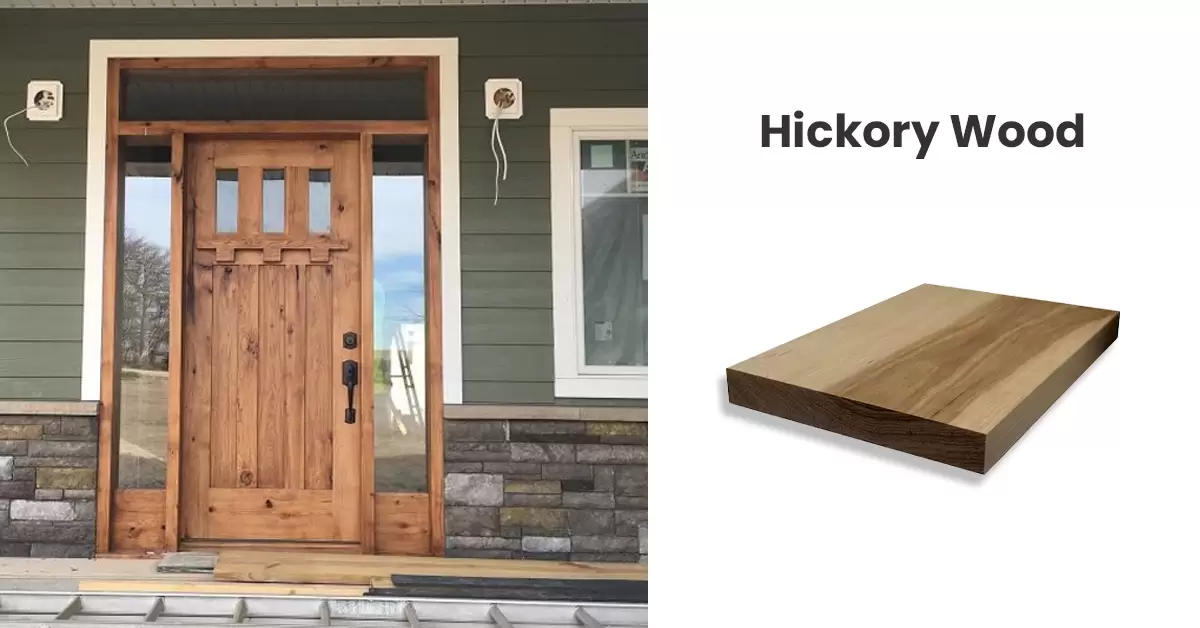
Hickory wood is renowned for its exceptional strength and durability, making it an excellent choice for interior and exterior doors. It features a striking combination of light and dark color variations, creating a visually appealing and unique look. Hickory’s prominent grain patterns add character and charm to doors, especially in rustic or farmhouse-style designs. However, it is important to note that hickory is a harder wood and may require more effort during the installation and finishing process.
Advantages of Hickory Wood
- Exceptional strength and durability, make it highly resistant to wear and tear.
- The striking combination of light and dark color variations adds visual interest.
- Prominent grain patterns enhance the overall character and charm of the wood.
- Ideal for rustic or farmhouse-style designs.
- Suitable for both interior and exterior applications.
- Longevity and ability to withstand heavy use.
Disadvantages of Hickory Wood
- Harder wood, which can make it more challenging to work with.
- Requires proper tools and techniques for shaping and installation.
- Higher cost compared to some other wood types.
- Natural color variations may not appeal to those seeking a more uniform appearance.
- May show scratches and dents more prominently due to its hardness.
- Requires regular maintenance and refinishing to preserve its appearance.
Oak Wood:
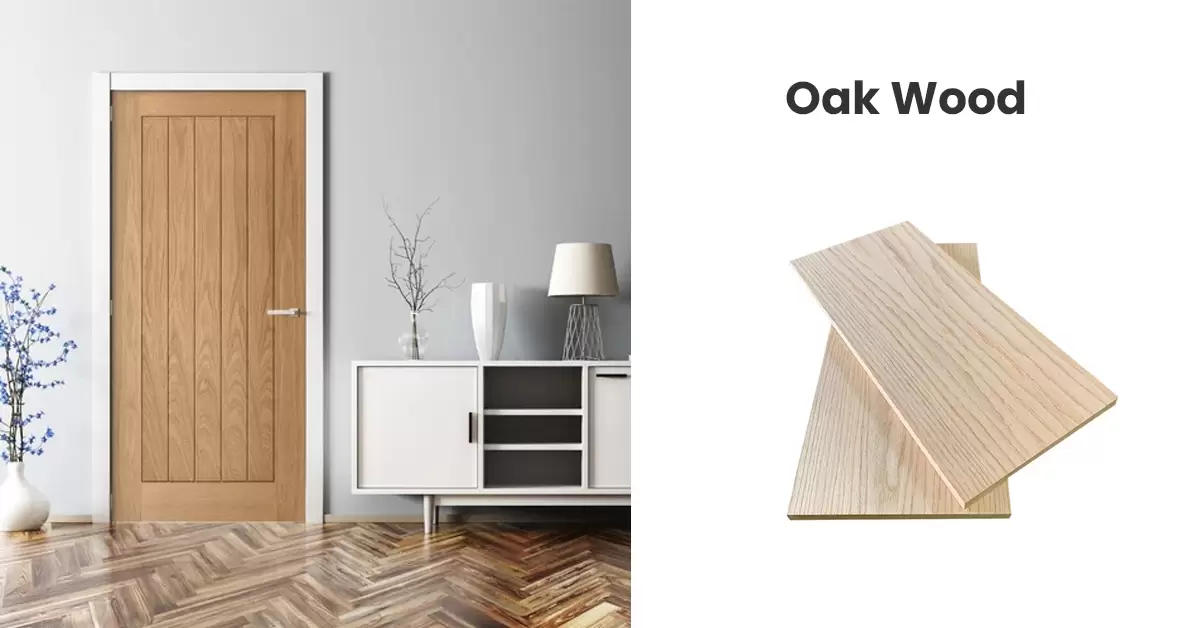
Renowned for its strength and durability, oak wood is a popular choice for doors. With its distinct grain patterns, oak offers a timeless and classic appeal. It is available in two main varieties: red oak, known: for its warm tones, and white oak, which exhibits a lighter, more natural appearance. Oak doors are not only visually appealing but also highly resistant to wear and tear, making them an excellent long-term investment.
Advantages of Oak Wood
- Strong and durable, making it highly resistant to wear and tear.
- Prominent grain patterns and natural variations add character and charm.
- Available in two main varieties: red oak and white oak, offering different aesthetics.
- Can be stained or finished in various ways to achieve desired colors and styles.
- Provides a timeless and classic look, suitable for both traditional and contemporary designs.
- Relatively more affordable compared to some other hardwood options.
Disadvantages of Oak Wood
- Heavier than some other wood types, requiring proper installation and support.
- Can be more challenging to work with due to its hardness.
- Red oak may be prone to visible grain patterns, which may not be preferred by some.
- Natural tannins in oak can react with certain finishes, requiring careful selection.
- Requires regular maintenance and refinishing to preserve its appearance.
- May show scratches and dents more prominently due to its hardness.
Mahogany Wood:
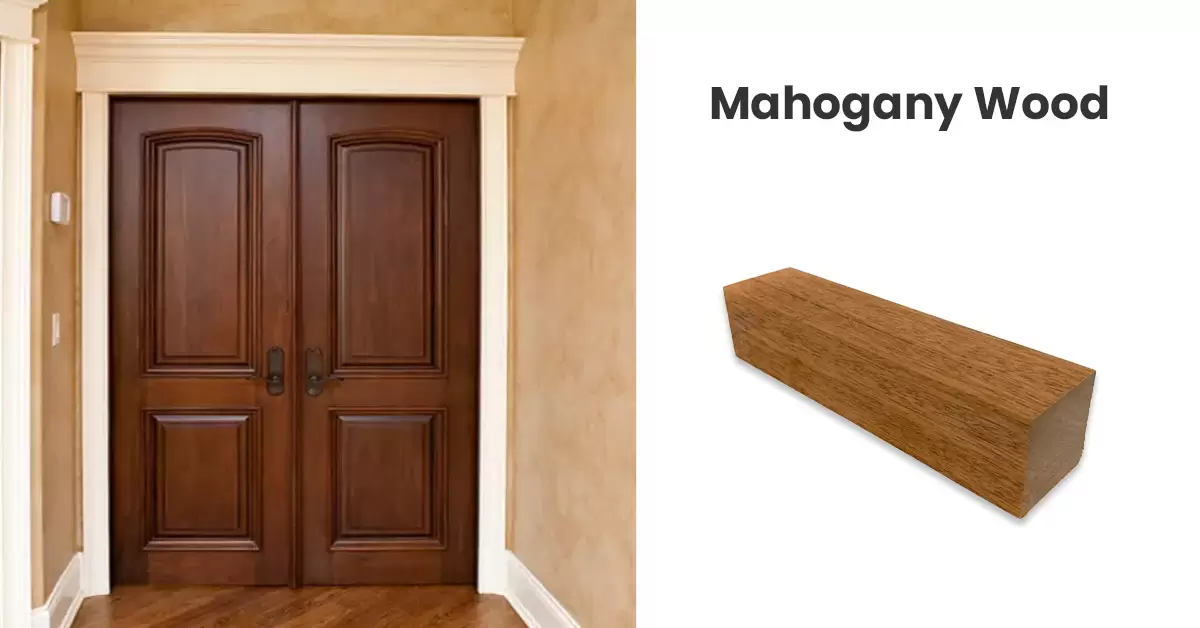
Mahogany wood is revered for its rich, reddish-brown color and remarkable durability. It’s natural luster and fine grain give doors a luxurious and sophisticated look. Mahogany doors are known for their resistance to warping, making them an ideal choice for areas with fluctuating humidity levels. With their regal appearance, mahogany doors make a statement and elevate the overall aesthetic of any home.
Advantages of Mahogany Wood
- Rich and luxurious appearance with its deep reddish-brown color.
- Highly durable and resistant to rot, decay, and pests.
- Fine and even grain pattern, providing a smooth and polished look.
- Ages beautifully, developing a desirable patina over time.
- Excellent workability, making it easy to shape and carve.
- Adds an air of elegance and sophistication to any space.
Disadvantages of Mahogany Wood
- Higher cost compared to many other wood types.
- Can be heavy, making it more challenging to handle and install.
- Limited availability in certain regions, impacts accessibility.
- Requires regular maintenance to preserve its appearance and protect against moisture.
- Darkens over time, especially when exposed to sunlight.
- May show scratches more prominently due to its dark color.
Maple Wood:
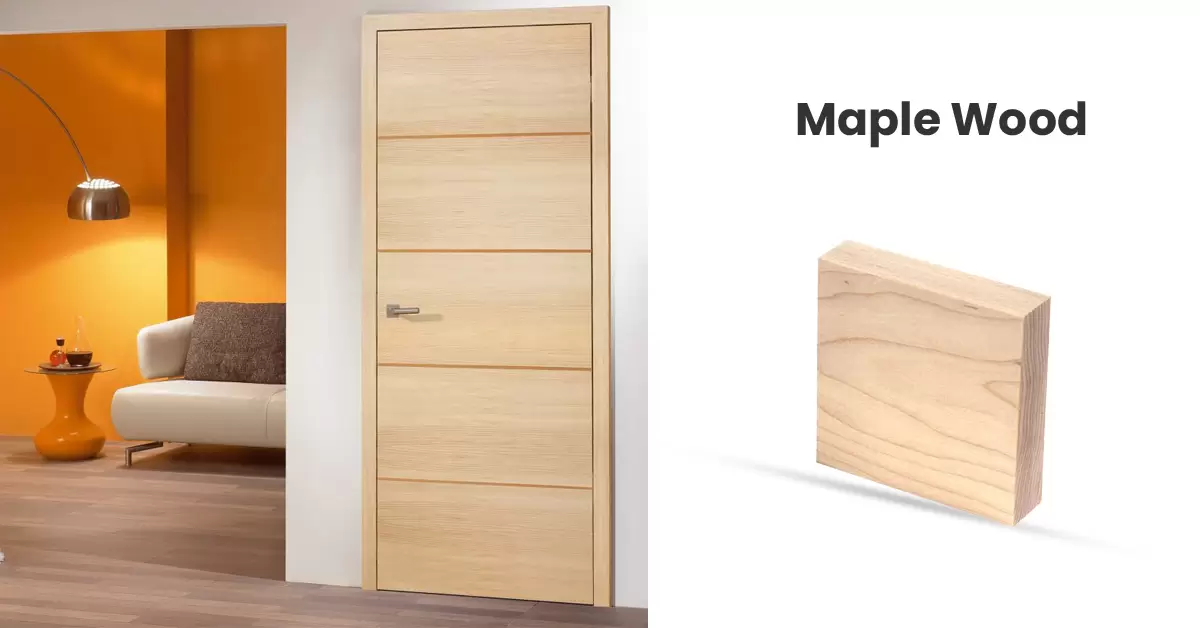
Maple wood, with its light and pale hue, offers a versatile option for door construction. Known for its strength and durability, maple doors can withstand everyday wear and tear. The fine grain of maple provides a smooth and even finish, making it an ideal choice for modern and contemporary interior designs. Maple doors can be stained to achieve various shades, adding flexibility to match your preferred aesthetic.
Advantages of Maple Wood
- Hard and durable, making it resistant to wear and tear.
- Smooth and even grain pattern, providing a clean and uniform appearance.
- Versatile and adaptable, suitable for various interior design styles.
- Accepts stains and finishes well, allowing for customization.
- Light color and natural luster brighten up spaces, creating a fresh and inviting ambiance.
- Relatively affordable compared to some other hardwood options.
Disadvantages of Maple Wood
- Can be more difficult to work with due to its hardness.
- May show signs of yellowing over time, especially when exposed to sunlight.
- Limited natural color options, typically ranging from pale cream to light brown.
- Requires regular maintenance to preserve its appearance and protect against moisture.
- Can be susceptible to scratches, although they are less noticeable due to the wood’s light color.
- Natural variations in color and grain may exist, which can be seen as a pro or con depending on personal preference.
Cherry Wood:
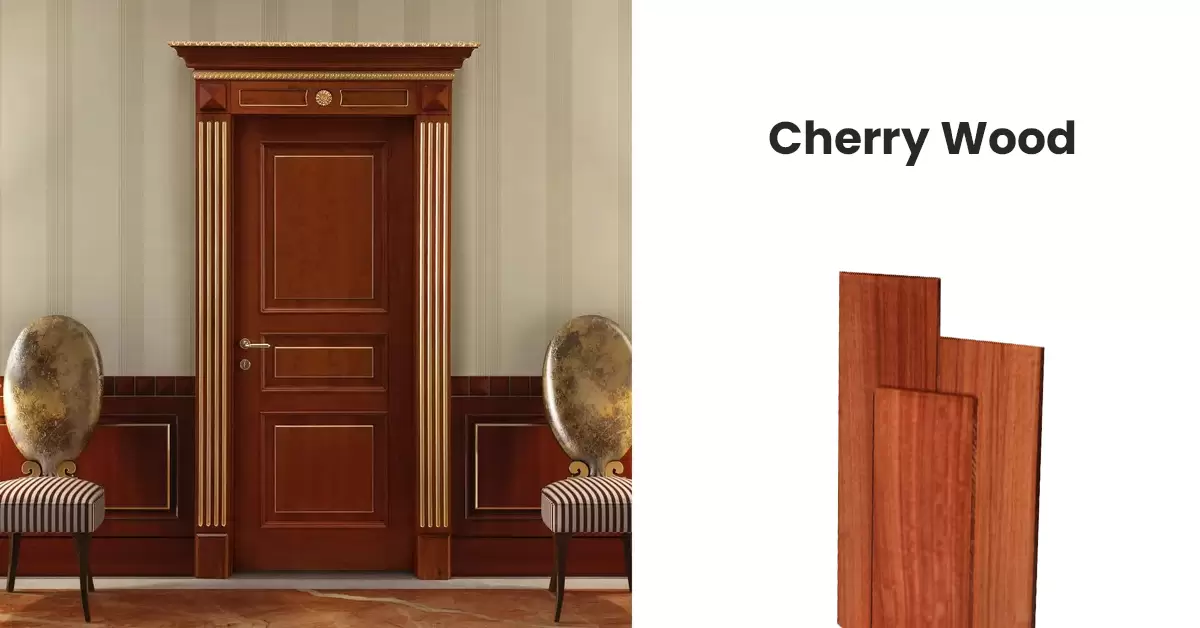
Cherry wood is cherished for its deep, reddish-brown color that develops a beautiful patina over time. With its rich hues and natural warmth, cherry doors bring an air of elegance and sophistication to any space. While softer than some hardwoods, cherry doors can be protected with appropriate finishes to ensure their longevity. The unique aging process of cherry wood enhances its charm, making it a sought-after choice for interior doors.
Advantages of Cherry Wood
- Rich and elegant aesthetic with its deep reddish-brown color.
- Develops a beautiful patina over time, enhancing its natural beauty and charm.
- Adds warmth and sophistication to any space, creating a luxurious atmosphere.
- Versatile wood that complements various interior styles, from traditional to modern.
- Can be finished to achieve different levels of shine and depth.
- Resistant to warping when properly cared for and maintained.
Disadvantages of Cherry Wood
- Relatively softer compared to some other hardwoods, making it more susceptible to scratches and dents.
- Requires regular and proper maintenance to protect the wood and maintain its luster.
- Initial color may darken over time, especially when exposed to sunlight.
- Can be more expensive compared to other wood types, impacting budget considerations.
- Natural variations in grain patterns and color may exist, which can be seen as a pro or con depending on personal preference.
- Requires careful consideration of finishes to preserve its natural aging process and prevent unwanted changes in appearance.
Walnut Wood:
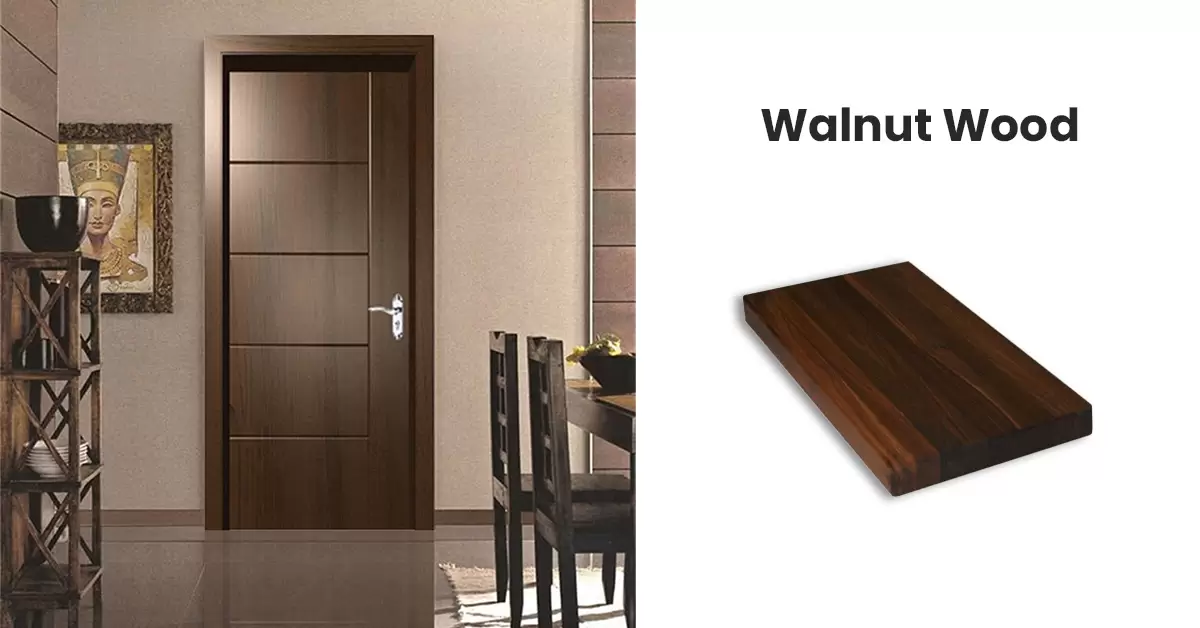
Walnut wood showcases a dark and distinctive grain pattern with rich brown hues. Its deep, luxurious color adds a sense of warmth and sophistication to door designs. Walnut doors are highly versatile, complementing a variety of interior styles, from traditional to modern. The durability and unique aesthetics of walnut make it a popular choice for creating a striking visual impact.
Advantages of Walnut Wood
- Rich and distinctive grain patterns with a dark brown color.
- Provides a luxurious and sophisticated look to any space.
- Offers warmth and depth, adding character and elegance to interior designs.
- Highly versatile and complements various styles, from traditional to modern.
- Durable and resilient, making it suitable for long-lasting furniture and flooring.
- Ages beautifully, developing a patina that enhances its natural beauty.
Disadvantages of Walnut Wood
- Expensive compared to other wood types.
- Softer than some hardwoods, making it more prone to scratches and dents.
- Requires proper maintenance and care to preserve its appearance.
- Can darken over time when exposed to sunlight.
- Natural variations in color and grain patterns may exist, which can be seen as a pro or con depending on personal preference.
- Limited availability in certain regions, impacts accessibility for some buyers.
Pine Wood:
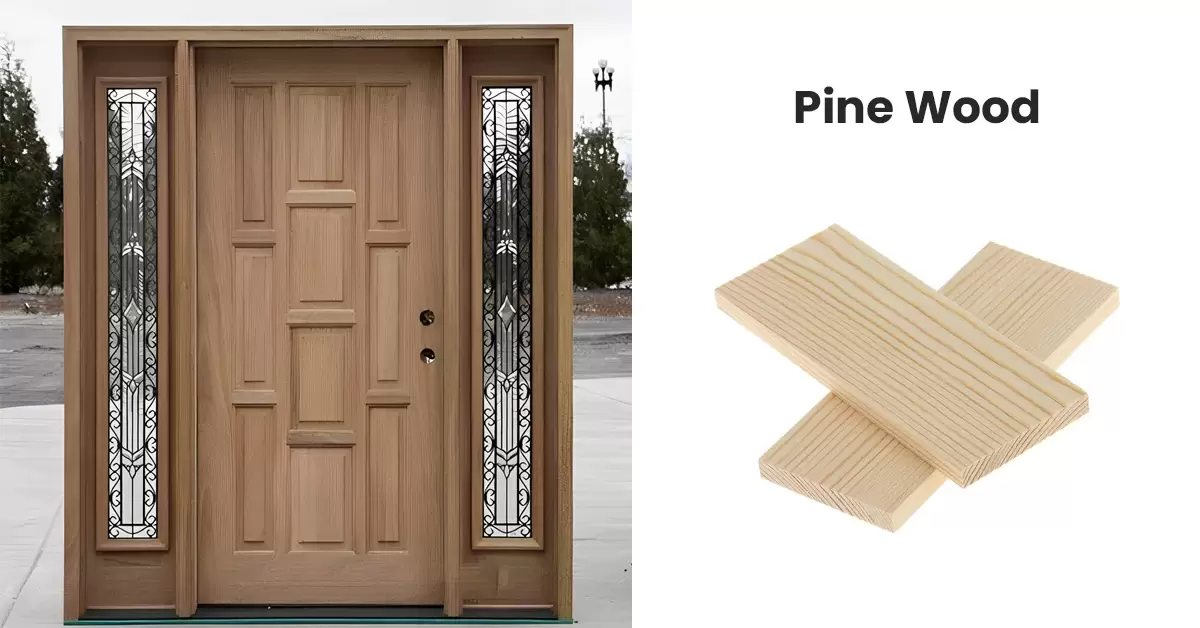
Pine wood, a softwood option, offers a light and inviting look. Its straight grain and pale color lend themselves well to creating a cozy and rustic atmosphere. Pine doors are commonly used in cottage-style or country-inspired interiors. While they may be softer than hardwoods, pine doors are affordable and can be protected with appropriate finishes to ensure longevity.
Advantages of Pine Wood
- Affordable and cost-effective compared to other wood types.
- Light and inviting appearance with a straight and even grain pattern.
- Creates a cozy and rustic atmosphere, ideal for cottage-style or country-inspired interiors.
- Easy to work with and can be readily customized or shaped.
- Accepts stains and finishes well, allowing for a variety of color options.
- Sustainably sourced and widely available, making it an environmentally friendly choice.
Disadvantages of Pine Wood
- Softer than hardwoods, making it more prone to dents, scratches, and wear.
- Requires proper sealing and maintenance to protect against moisture and damage.
- Can have knots and resinous pockets, which may affect the overall finish and aesthetics.
- Limited natural color options, usually ranging from pale yellow to light brown.
- Susceptible to warping or twisting if not properly handled or acclimated.
- May not have the same level of durability and longevity as some hardwoods.
Conclusion:
Selecting the right wood for your doors is a significant decision that impacts the visual appeal and durability of your home. Understanding the unique characteristics of different wood types is crucial. Consider factors such as durability, maintenance requirements, and the desired ambiance when choosing the ideal wood for your doors. By making an informed decision, you can create doors that enhance the beauty and charm of your living spaces while standing the test of time.

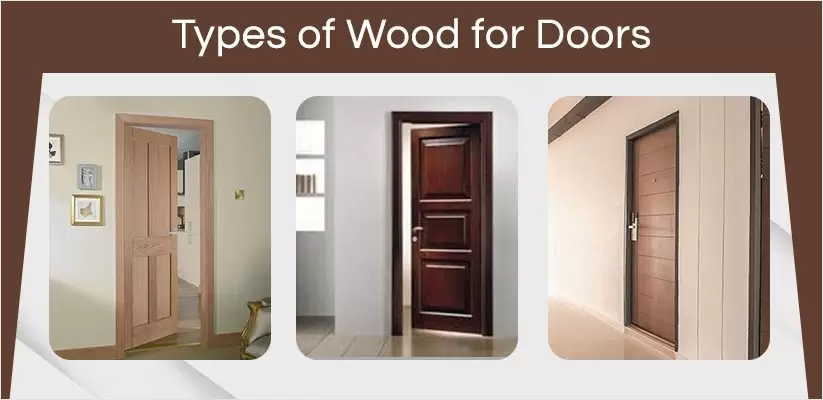
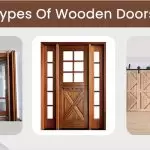

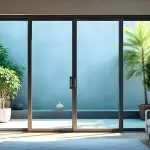


















Post A Comment